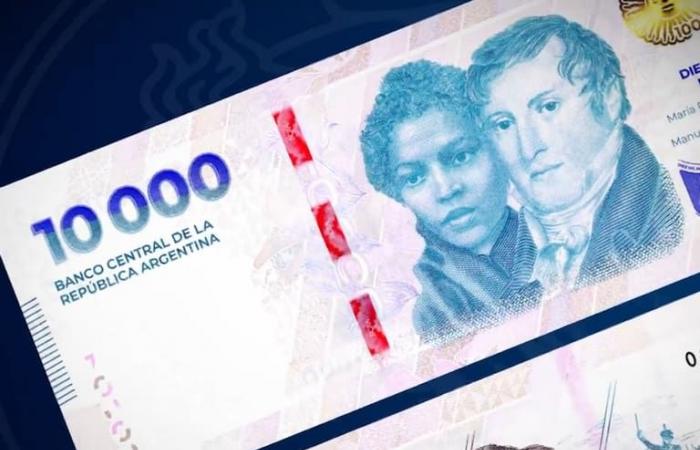Hear
Slowly, the $10,000 bill It is incorporated into the daily lives of Argentines. Since the beginning of May, when the Central Bank (BCRA) announced that the first five-digit bill would enter circulation and began filling ATMs with these papers, 211.6 million units are already circulating.
One month after its launch, it represents 1.82% of the 11,654 million banknotes in circulation as of June 14, according to official data published by the Central Bank and processed by LA NACION Data. However, the pace was growing rapidly: in mid-May there were only 19.8 million of these papers (0.17% of the total) and on June 3 the figure rose to 95 million (0.82%).
The arrival of a bill with a larger denomination had been expected for a long time, especially after inflation accelerated to three digits and reached values only comparable with the hyperinflation of 1990. The last time a bill was released was the $2000 bill, in May of last year, but it was equivalent to US$4.13 (to the MEP).
That complicated the daily economy in several aspects. ATMs are easily emptied and on many occasions customers leave with fewer bills than they need, since the machines are configured to deliver a certain number of units per transaction. While banks and merchants report having storage problems, higher logistics and security expenses.
This is explained because 53.17% of the bills in circulation on Argentine streets are $1000 bills. A paper that today, in the supermarket, is enough to buy a second-brand alfajor. Those of $500 have a prominence of 14% of the total circulation, followed by those of $2000 (9%) and $200 (3%).
“The $10,000 bill, as well as the $20,000 one with the image of Juan Bautista Alberdi that will enter circulation in the last quarter of the year, It will facilitate transactions between users, make the logistics of the financial system more efficient and will significantly reduce the costs of acquiring finished banknotes. “Both banknotes belong to the ‘Heroines and Heroes of the Homeland’ family,” the Central Bank said in May.
The expectation is that in the coming months the $10,000 bill will make a place in the wallets of Argentines. Currently, it has a value equivalent to US$7.8 (to the MEP) and US$10.81 to the official retail. Meanwhile, at the end of this year the $20,000 will be introduced, which today would have a value of US$15.7 at the free exchange rate. Even so, These figures are less than the US$57 that the $1000 came to represent as soon as it hit the streets.at the end of 2017, by decision of the then president Mauricio Macri.
Since then, the value of the hornero bill has practically disintegrated. However, In the previous government they refused to issue larger denomination banknotes. For the former vice president, Cristina Kirchner, This was a way of recognizing inflation, which is why he previously did not want to create the $200, $500 and $1000 bills either.
It was not until the beginning of last year that the Central Bank announced that it would issue a larger denomination paper, but was disappointed when it became known that it would be $2,000. “The way in which people make payments in our country has been experiencing an important change towards greater use of electronic means.a process that has been decisively promoted by the BCRA through innovative and high-impact measures and programs, such as Transfers 3.0,” the Central Office justified at that time, to explain the delay of that unusual decision.
The $10,000 bill incorporated a series of security elements, from the printing and the materials used, intended to be recognized by both users and ATMs and automatic machines.


